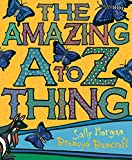This alphabet book is unusual for several reasons. First, although there are other Australian alphabets, this one introduces several animals that young readers (and adults!) may not know - such as the Chuditch, the Ulysses Butterfly and the Velvet Worm. Second, there is a narrative running throughout the alphabet, which links each letter to the next. The thread is that Anteater has something amazing to show her friends, but each one she approaches in the hope that they will be interested, simply pushes her on to the next animal in the alphabet. They are all too busy engaged in some characteristic pursuit to respond to Anteater, who is supposedly their friend. Third, the narrative is about emotions. Although it catalogues native animals A to Z, the narrative compiles an impressive list of emotions that Anteater hopes her friends will express: perhaps they will celebrate, feel joy, dance, be gleeful, giggle at, hoot at, laugh at - and so on.
There are some interesting readaloud elements included here. Sometimes the text predicts the next letter/ sound in the alphabet - for example, Quokka is told that the secret will 'rattle' her; Rat is told he might 'shiver' when he finds out what Anteater has to share with him. Even when the text does not manage this neat dovetailing of sounds, there is plenty of read-aloud interest in the range of words offered to young readers.
The fourth salient point about this narrative comes from Sally Morgan's teachers' notes rather than explicitly from the text: and that is the possibility of engaging male readers. The withholding of emotional expression has long been inscribed in masculine culture, and non-Indigenous Australian mythology generally. It can also be argued that the withholding of emotional expression and flat affect can be identified in young people who are at risk, or who are survivors of trauma. For this reason, the celebration of emotions in the narrative my have some therapeutic value - and the fact that this potential is not explicit in the text only increases its likely usefulness. Much has been made in the past 30 years of concerns about literacy and the need to highlight 'Books for Boys'. Here is a book about animals and insects, with a strong narrative thread about expressing emotions - and note that the emotions are withheld because each animal is too busy. So the world of feelings and the world of work are being contrasted. The grasshopper and the ant. The relevance to gender politics is subtle but unmistakable.
Finally, the connecting narrative invites the reader to keep turning the pages in the hope of solving the mystery of just what it is that Anteater knows will excite her friends. The mystery remains on the final page, offering opportunities for young readers to discuss what it is that has held the story together. One clue is in Bancroft's illustrations, and it is a metanarrative element. Anteater is holding a book. So it is a book within a book. The playful twist is that the secret has been present throughout: it is the book itself that will engage us, invite us to express our emotions, and create a community. The book, story itself, therefore, is the A to Z Thing. The alpha and omega. The beginning and the end. Bronwyn Bancroft's dedication confirms such an interpretation: 'To all the children in the world who love reading as much as I do.'

